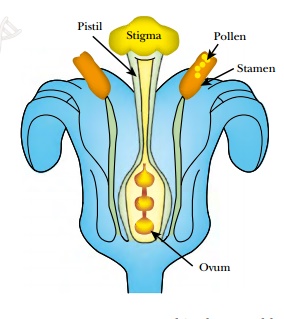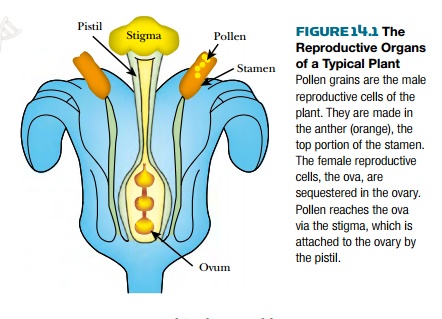Chapter: Biotechnology Applying the Genetic Revolution: Transgenic Plants and Plant Biotechnology
History of Plant Breeding

HISTORY
OF PLANT BREEDING
For thousands of years humans
have improved crop plants and domestic animals by selective breeding, mostly at
a trial-and-error level. Over many years, animal and crop breeders have learned
that improving their crops and animals has a biological basis. In fact, the
father of genetics, Gregor Mendel, experimented with the common pea. He studied
easily identified traits such as round versus wrinkled seeds or yellow versus
green seeds. Mendel would take the pollen from one plant and put it on the
stigma of another plant (Fig. 14.1), a procedure called cross-pollination. His experiments showed that plants have some
traits that may dominate others. For example, a cross between a yellow-seeded
pea plant and a green-seeded pea plant gave only seeds that were yellow. This
work was published in 1865, but no one understood the importance of these
findings until well after Mendel’s death.

Many scientists around the
world still use traditional breeding techniques to enhance crop yields,
increase resistance to various pests or diseases, or increase the tolerance of
a particular crop to heat, cold, drought, or wet conditions. Although simply
crossing a high-yielding plant with another can produce offspring with even
higher yields than either parent, the process is long and tedious. Many
thousands of plants must be cross-pollinated to find the one offspring with
higher yield. The crosses must be done by hand, that is, pollen must be taken
from one plant and manually placed on another. In addition, the possibility of
finding improved traits is limited by the amount of genetic diversity already
present in the plants. Consequently, if the two plants that are crossed share
many of the same genes, the amount of possible improvement is limited. If a
plant has no genes for disease resistance, there is no way traditional
cross-pollination will develop that trait. Therefore, scientists have searched
for better ways to improve plants.
In the 1920s, scientists
realized that mutations could be induced in seeds by using chemical mutagens or
by exposure to X-rays or gamma rays. Although useful, the outcome of such
treatments is even less predictable than traditional breeding methods. Nonetheless,
mutation breeding has been successful, especially in the flower world. For
example, new colors and more petals have been expressed in flowers such as
tulips, snapdragons, roses, chrysanthemums, and many others. Mutation breeding
has also been tried on vegetables, fruits, and crops. Some of the varieties of
food we eat today were developed using this method. In short, a large number of
seeds are exposed to the mutagen to generate various mutations in their DNA.
The seeds are then planted and cultivated.
However, the majority of
seeds are killed by the treatment. After the viable seeds are grown, the fruit,
flower, or grain of the plant is tested for improvements. If one plant is found
with a desirable trait, then its progeny are tested for the trait. Novel traits
are only useful if they are heritable, that is, passed from one generation to
the next. Because only one original mutant plant would gain any particular
desirable trait, this plant would need to be propagated a long time before any
of the fruit, grain, or flower would be sold to market. It is important to
realize that the actual fruits or flowers sold to the consumer were never
exposed to the mutagen. Today, chemical mutagens are still used, but molecular
biology techniques are being used to identify the actual gene associated with
the desired phenotype (see later discussion).
Recently, the emergence of
molecular biology has opened the door to a much more predictable way to enhance
crops. Scientists have discovered ways to move genes from foreign sources into
a specific plant, resulting in a transgenic
plant. The foreign gene, or transgene,
may confer specific resistance to an insect, or protect the plant against a
specific herbicide, or enhance the vitamin content of the crop. The major difference
between transgenic technology and traditional breeding is that a plant can be
transformed with a gene from any source, including animals, bacteria, or
viruses as well as other plants, whereas traditional cross-breeding methods
move genes only between members of a particular genus of plants. Furthermore,
the transgene has a known function and has been evaluated extensively before
being inserted in the plant. During traditional breeding, the identity of genes
responsible for improving the crop is rarely known.
Related Topics